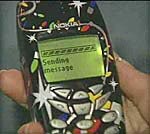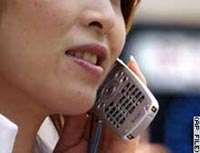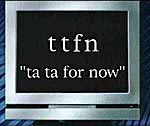| (insert your NIE or newspaper logo here) |
Weekly Online LessonOnline Lesson ArchiveGrade Level: 6-9
|
Communication Overload
 At
about 4 million e-mails a day, no one gets more junk mail than Microsoft's
Bill Gates. Fortunately, Gates said at a conference in Singapore last
week, he's got an entire department devoted to spam filtering so he
can stay focused on the messages that really matter to him.
At
about 4 million e-mails a day, no one gets more junk mail than Microsoft's
Bill Gates. Fortunately, Gates said at a conference in Singapore last
week, he's got an entire department devoted to spam filtering so he
can stay focused on the messages that really matter to him.
For anyone who communicates using e-mail, mobile phones and text messaging, keeping connected with others is easier than ever, despite the hassles of junk mail.
A growing number of people worldwide now use these technologies, and the effects are changing parts of our culture. Besides being able to talk to people "on demand," languages have begun to adapt to these new modes of communication, as well. This is evident in how modern vocabularies have grown to include shortcuts like LOL for "laugh out loud" and BRB for "be right back."
 With
the biggest shopping day of the year -- the day after Thanksgiving --
just around the corner, you're guaranteed to hear about all of the different
gadgets and services that either get you more connected or keep others,
like spammers, disconnected from you.
With
the biggest shopping day of the year -- the day after Thanksgiving --
just around the corner, you're guaranteed to hear about all of the different
gadgets and services that either get you more connected or keep others,
like spammers, disconnected from you.
To get some insight into how these new modes of communication may be shaping today's world -- and that of the future -- you'll take a trip through time to find out how language, and other ways of communicating, have evolved. Then you'll learn how the specific technologies of e-mail and spam work.
The Evolution of Communication
 Begin
your journey with the ThinkQuest site, Reaching
Out: The Evolution of Communication.
Begin
your journey with the ThinkQuest site, Reaching
Out: The Evolution of Communication.
Click Enter Site, then choose either the Normal or Java version.
Browse the Timeline, from the Prehistoric Era, to 1 A.D., to 1400 A.D., to the 1600s and 1700s.
How exactly did the development and use of paper evolve over time and in different regions of the world? What role did hand-writing and printing play in spreading literacy and education? Why was the importance of mail service?
What new inventions spread during the 1800s, and how did they change the ways in which societies lived, worked, and interacted with one another?
Now, browse through the 10 decades of the 20th Century.
In what ways did technology change different aspects of our culture? For example, consider local communications (personal and business-related), international connections, art, entertainment, advertising, etc.
After looking so intensely at some of the technologies of communication, let's turn our attention to some non-verbal types of communicating -- Signs, Symbols, Etc. Here, you'll learn about Communication by Drums, Runes, Smoke Signals, and Traffic Signs.
 Also
discover the roles that the Spoken
Word and Written
Word played in the development of modern cultures.
Also
discover the roles that the Spoken
Word and Written
Word played in the development of modern cultures.
What kinds of things did these allow people to do that was difficult or impossible before the spread of these developments?
Next, think about Mass Media -- how has mass media changed over time in response to the evolution of communication? In what ways has mass media influenced the evolution of communication?
Do your family and friends tend to communicate through spoken words, written words, or sign language? In what ways does the language you use to communicate change depending on the mode (meaning through a device or face-to-face)?
"You've Got (Junk) Mail!"
Now let's focus on the specific technology of How E-mail Works.
Read the introduction then learn more about what exactly An E-mail Message is and what E-mail Clients do.
Then, discover how A Simple E-mail Server works and compare that with The Real E-Mail System, which includes The SMTP Server, and either a POP3 Server or a IMAP Server.
 What
exactly does and SMTP server do? Why is an IMAP server more helpful
in managing your inbox than using a POP3 server? How does e-mail affect
the way you communicate with others?
What
exactly does and SMTP server do? Why is an IMAP server more helpful
in managing your inbox than using a POP3 server? How does e-mail affect
the way you communicate with others?
Of course, most people would rather not have to wade through a lot of junk mail to read messages from their friends, so next let's explore How Spam Works and how it can be controlled.
After reading the introduction, discover The Source of Spam, answer the question, "How Do They Get My Address?"and take a look at some of The Big Spamming Companies.
What would motivate people to become spammers? What are the different ways in which spammers can find and use your email address?
Lastly, see how Stopping Spam works. Does your school or home Internet service offer spam blocking? If so, how well do you think it works? Does the service allow you to customize the filter settings? How much spam do you or someone you know receive daily or weekly? How does spam influence the way you use e-mail?
Newspaper Activities
Browse current issues of Targetnewspaper, looking for news, features or advertisements for communication devices or services. In what ways do the products or services compare with one another in how they could help people get connected locally and over long distances? Are any advice columns suggesting ways to manage your inbox or spam filtering? Also, try to find any news about how governments and other cultures are responding to the use of e-mail, text messaging, mobile phones, and spam.
© Copyright 2004
Learners
Online,
Inc.
